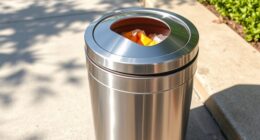To tackle bathroom smells, I focus on improving ventilation by using exhaust fans or opening windows to reduce humidity. I also check and clean traps regularly, like sink and toilet traps, to prevent odors from escaping. Good cleaning habits are key; I scrub surfaces, mold-prone areas, and use natural fresheners to keep things fresh. If you want to uncover more simple tips to eliminate stubborn odors, keep exploring these solutions further.
Key Takeaways
- Proper ventilation, including exhaust fans, reduces humidity and prevents mold growth that causes bathroom odors.
- Regularly cleaning and disinfecting drains, traps, and surfaces removes bacteria and debris that produce smells.
- Checking and sealing the toilet wax ring and plumbing seals prevents sewer gases from escaping into the bathroom.
- Using air fresheners strategically near vents and high-traffic areas maintains a fresh scent and masks persistent odors.
- Keeping surfaces dry, wiping down damp areas, and applying mold-resistant paints help minimize mold and bacterial odor sources.

Few things are as frustrating as walking into a bathroom and being greeted by an unpleasant smell. It’s a common problem, but thankfully, there are effective ways to tackle it. One of the first steps is understanding how to use air freshener techniques properly. Instead of just spritzing a quick burst of scent, I’ve found that strategic placement and timing make a big difference. For example, using automatic air fresheners or placing scented diffusers near vents helps maintain a consistent, fresh aroma. I also like to keep a small spray bottle of natural air freshener in the bathroom for quick touch-ups, especially after use. But scent alone isn’t enough; you need to address the root causes of odors, which often involve mold and bacteria buildup.
Mold prevention strategies are essential for keeping bathroom smells at bay. Mold thrives in damp, poorly ventilated areas, so I always make sure to keep the space dry and well-ventilated. Running the exhaust fan during and after showers significantly reduces moisture, preventing mold from taking hold. I also wipe down surfaces regularly—especially around the sink, toilet, and shower—to remove any lingering dampness or soap scum that could promote mold growth. Using mold-resistant paint and sealants on bathroom walls and tiles is another smart move, creating a barrier against moisture intrusion. In addition, I pay attention to hidden areas like behind the toilet and under sinks, where mold can develop out of sight.
Beyond mold prevention, I incorporate simple cleaning routines that help eliminate odor-causing bacteria. Regularly scrubbing the toilet bowl, sink, and shower with disinfectant keeps bacteria levels low. I also clean the drain traps routinely because they can trap debris and emit foul smells if left unchecked. Ensuring the toilet’s wax ring is intact is another critical step, as a broken seal can cause persistent odors. For deeper cleaning, I sometimes use vinegar and baking soda—they’re natural, effective, and help neutralize odors without harsh chemicals. Proper ventilation is also key, as it helps remove airborne pollutants and reduce humidity levels.
All these measures, combined with good ventilation and consistent cleaning, create an environment where bathroom smells are minimized. I’ve learned that addressing moisture and mold prevention is just as important as using air freshener techniques—they work hand in hand. Keeping the bathroom dry, clean, and well-ventilated, along with strategic scenting, is the best way to guarantee your bathroom remains fresh and odor-free.
Frequently Asked Questions
How Can I Prevent Mold Growth Behind Bathroom Tiles?
To prevent mold growth behind bathroom tiles, I always use mold-resistant tiles and ensure proper bathroom sealing. I regularly check for any cracks or gaps in the sealant and reseal them as needed. Good ventilation is essential, so I run the exhaust fan during and after showers. Keeping the area dry and cleaning tiles with mold-inhibiting solutions also helps me stay ahead of mold growth.
What Are Natural Remedies for Persistent Bathroom Odors?
Oh, because what’s more charming than a bathroom that smells like a fresh garden? I swear by air purifying plants like aloe and spider plants—they do wonders without chemicals. And for stubborn odors, I sprinkle baking soda remedies around, letting them soak up smells naturally. It’s like giving my bathroom a whiff of fresh air—literally—without the artificial perfume overload. Trust me, these natural tricks work wonders!
How Often Should Bathroom Ventilation Systems Be Cleaned?
I recommend cleaning your bathroom ventilation system every 3 to 6 months to maintain ideal odor control strategies. Regular ventilation maintenance prevents dust buildup and mold, which can worsen odors. If you notice persistent smells despite cleaning, consider increasing the frequency or checking for blockages. Staying on top of ventilation upkeep ensures fresh air circulation and keeps your bathroom smelling clean and inviting.
Can Certain Cleaning Products Cause Lingering Smells?
When it comes to cleaning products, they can definitely cause lingering smells if they create unwanted chemical reactions or if they’re too harsh on air quality. I’ve seen it happen myself—strong fragrances or residue can stick around longer than expected. Always opt for eco-friendly cleaners and make sure proper ventilation during and after cleaning. That way, you prevent those persistent odors and keep your bathroom smelling fresh as a daisy.
What Are Signs of a Plumbing Vent Blockage?
If you notice gurgling sounds from your drains or slow drainage, these are strong signs of a plumbing vent blockage. You might also see sewer odors lingering or water levels in your toilet fluctuating unexpectedly. These are common blockage symptoms that indicate your plumbing vent isn’t functioning properly. I recommend checking for obstructions outside the vent pipe, like debris or bird nests, to restore proper airflow and prevent further issues.
Conclusion
If you’ve ever wondered whether a quick spray can hide bathroom odors forever, the truth is, it’s only a temporary fix. Proper ventilation, fixing traps, and regular cleaning are the real solutions that keep your bathroom smelling fresh long-term. I’ve found that addressing the root cause — like a dry trap or poor airflow — makes all the difference. So, next time, skip the sprays and focus on these basics for a truly pleasant bathroom experience.








